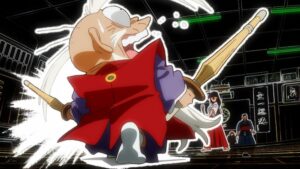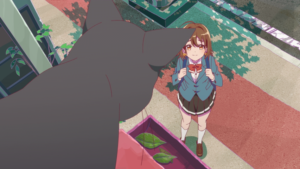Wooper: We interrupt your regularly scheduled first impressions to bring you one man’s overdue post on the recently concluded anime season. My thoughts on one show in particular proved particularly hard to wrangle, but eventually I managed to get something on the page, so here’s the last of spring’s biweekly check-ins. As for whether the column will continue into the summer, I haven’t made my final decision yet – you’ll have to stay tuned to find out!
Shin Samurai-den Yaiba – 12-13
After Yaiba’s supercharged confrontation with Onimaru a couple weeks ago, these two episodes brought the intensity down to a familiar level. As of episode 13, we’ve returned to searching for elemental orbs, battling animal-themed ogres and encountering pseudo-historical samurai – but before that, we met new character Yamato Nadeshiko and learned of her history with Yaiba. Her name is identical to a phrase meaning “ideal Japanese woman,” so of course she seeks to marry Yaiba and become a perfect wife, but in spite of that silly premise, I really liked the six year flashback to their first meeting. Her attempts to mimic his moves in the jungle (where she was on an expedition with her father) were endearing, and the electro-rock track that played behind that montage had a suitably fun, adventurous vibe. In the present, her mastery of the naginata made for some decent fight scenes, though they were mostly comedic in nature despite her romantic determination. The info she provided about the Dragon Orb eventually sent the whole crew on a journey to Lake Biwa, where Yaiba and Sayaka were faced with a giant octopus possessed by the spirit of Miyoshi Seikai (a folkloric hero from the Sengoku period). Apart from some computerized waves here and there, the lake scenes played host to excellent animation, especially when Yaiba used his momentum to surf atop the water while riding a broken plank. He ended up with the wrong artifact by the end of the episode, but elemental orbs are just about the coolest MacGuffins there are, so I’m down for an extended artifact hunt if that’s where the show is headed.
Kowloon Generic Romance – 10-13
10-11: Prior to watching these two episodes, I’d felt as though KGR’s attention to its characters’ interior lives had been supplanted by the slow rollout of its simulation-based mystery. These two episodes didn’t do much to change that opinion, but I felt more kindly about them on the whole – they were less redundant and more revealing, and attempted to engineer a decent pause in Reiko and Kudo’s relationship. Regarding that last point, “attempted” is the operative word, since Reiko putting her own feelings on ice felt more narratively pragmatic than emotionally so. Her reasoning for wanting to slow down after their recent intimacy made sense on paper, at least, since she’s dedicating more and more of her time to her investigation into Kujirai B’s memories, which she can now glimpse through an old pair of the woman’s glasses. How that works I have no idea, but it’s one of the show’s coolest concepts yet, and it allowed us to explore the true manner of Kujirai’s death, which the show has been hinting wasn’t as simple as swallowing a bottle full of pills. Another great concept is KGR’s explanation for the layout of the present Kowloon – apparently it’s based on Kudo’s memory of the territory pre-demolition, which means it changes as he acquires new information. This even resulted in the second Xiaohei’s disappearance after Gwen spilled the beans about his true identity, but all of this new information begs the question: if Kudo’s memory shapes the simulated Kowloon, wouldn’t his death result in its termination? And if that’s the case, why is Yulong going after Reiko rather than Kudo?
12-13: My biggest question upon finishing this show was, “If this version of Kowloon was a simulation, and all the people who originated there were merely part of the simulation, then how was Reiko able to exist outside the boundaries of the demolition site?” I thought about it for a while, and although I didn’t come up with a scientifically satisfying answer (nor could I, since I’m not a scientist), I did settle on a sort of thematic explanation. The real reason for the Generic Terra project was for the Hebinuma patriarch to resurrect his son with all of his memories intact, so the potential for rebirth must have existed somewhere in that floating prism, right? If so, when the program hijacked Kudo’s memory to create the simulated Kowloon, it must have attempted to bring Kujirai back to life (since she was his biggest source of regret), drawing on whatever revitalizing power it possessed to do so. Since Kudo was convinced that he “didn’t know a thing about her,” though, she was brought back with physical differences and without her memories, resulting in the creation of a wholly original human being. If only these two episodes had been as original – if I’m being honest, the “simulation breakdown” scenes pulled together so many familiar concepts (a character watching memories on a movie screen, a man having an emotional dialogue with his clone, The Truman Show’s door in the sky) that they ended up feeling derivative. The production continued its slow descent all the way to the end, too, especially during the shots of Reiko stiltedly running to stay ahead of Kowloon’s crumbling streets. Right now my biggest feeling about this show is one of disappointment, but I do think it had a lot to offer on the whole. We’ll see where I land six months from now.
Lazarus – 12-13
For most of its run, Lazarus took a rather measured approach to averting the apocalypse, but these two episodes took place over the course of 24 hours, giving them a different feel than all the rest. More than anything else, it felt like the show was in a hurry to wrap itself up – a common occurrence when anime reach their endpoints, but here it was particularly jarring. At the start of episode 12, for instance, we saw Axel, Doug, and Eleina all awaken in different locations, each having survived a life-threatening crisis, yet all of them had recovered and gone into mission mode by the half hour’s end. Perhaps these too-coordinated developments would have gone down more smoothly if we hadn’t spent so much of the episode following Abel’s preparations to confront Schneider, on top of everything else. The standoff between those two men was filled with redundant dialogue, much of which rehashed the airport video that Abel revealed to Hersch in episode 10, and Schneider’s motivation for obstructing the search for Skinner didn’t compute whatsoever. But then, Lazarus’s plot never made much sense – the question here was whether the final episodes would deliver on a production standpoint. We did get some more hand-to-hand combat between Axel and Souryuu at the start of episode 13, which was nice, but when it came time for them to navigate the falling debris of Babylonia Tower, the storyboard failed to maintain the excitement of what had come before. Also, the final twist surrounding the Lazarus agents’ immunity to Hapna did nothing but make me question why they weren’t pulled from the field several episodes ago, so they could be lab rats in a last ditch effort to create a vaccine. Guess I shouldn’t think too hard about it and just be glad we got a cour’s worth of great action scenes, eh?
Apocalypse Hotel – 12
“There are two tragedies in life. One is not to get your heart’s desire. The other is to get it.” This quote came to the forefront of my mind while watching Apocalypse Hotel’s final episode, which centered on a human astronaut’s arrival at the Gingarou Hotel, marking the species’ return to their home planet for the first time in more than half a millennium. For as long as we’d known her, all Yachiyo wanted was for humanity to return to Earth – but once that wish was granted, she discovered that she was no more glad to welcome this astronaut than any other hotel guest. So what changed? Ponko had a reassuring explanation for her friend’s apparent emotional malfunction, but rather than rehash her theory (satisfying though their scene together was), I just want to praise the show’s timing with regard to Yachiyo’s evolving perspective. Positioning this story immediately after episode 11, where Yachiyo truly connected with herself and her environment for the first time, was a really smart decision. In essence, she deprogrammed herself during her time away from the Gingarou, and since her programming was the only thing that made her so desperate for humanity’s return, it was only right that she experienced that muted feeling at the fulfillment of her heart’s desire. For a full cour now, Apocalypse Hotel’s offbeat jokes have earned it the “quirky sci-fi comedy” label – even this episode’s penultimate scene featured Yachiyo humorously running along a beach in pursuit of a departing guest – but it was actually one of this spring’s better-written shows. I’m grateful that at least one of the season’s originals panned out, at least!
Mobile Suit Gundam GQuuuuuuX – 12
I know there are a lot of anime fans out there who are mad about Lazarus’s unmet potential, but personally, I found GQX’s multiversal clusterfuck to be much more distressing. Its fresh character designs tricked me into believing that the old guard of Gainax were just using Gundam 0079 as a jumping-off point for an entirely new story, but the siren song of nostalgia was too strong for their wrinkled asses to resist. Even though Anno wrote only two of GQX’s episodes, his fingerprints were all over this finale, right down to the massive white Gundam standing in for End of Evangelion’s Rei-Lilith hybrid, both of which were defeated when their opponents rejected the apocalypses they sought to usher in. And both of those opponents (Machu and Shinji, respectively) piloted mechs housing the souls of plot-critical characters, as revealed when Amuro’s voice emerged from the GQuuuuuuX with just minutes to go before the show’s conclusion. Actually, I probably ought to be thankful that this episode was largely powered by Member Berries, as the technobabble used to justify its story was arguably worse than the nostalgia itself. For example, just seconds after Shuji confessed his love for Machu and the two of them locked lips, we got a shot of Challia Bull and Char explaining that the GQuuuuuuX (real name “Endymion,” because why not) incorporated OOPArts from another timeline, allowing it to trigger a Zeknova in place of the Red Gundam. Combine that flavor of word salad with all the time the characters spent dialoguing on the Newtype plane, and you get the sort of conclusion that will underwhelm all but the most devoted Gundam addicts.
The post Spring 2025 Check-In – Weeks 12-13 appeared first on Star Crossed Anime.




